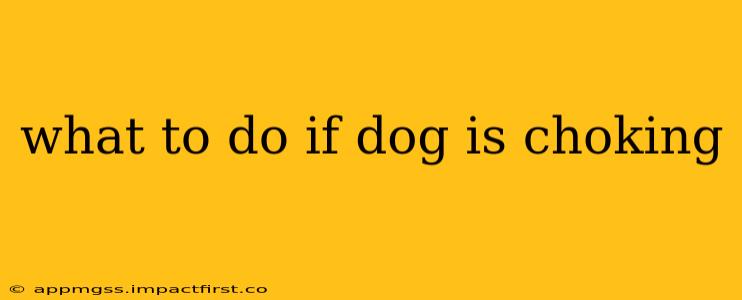What to Do if Your Dog is Choking: A Life-Saving Guide
A choking dog is a terrifying experience for any pet owner. Knowing what to do in this emergency can be the difference between life and death. This guide will walk you through the steps to take, from identifying the signs of choking to performing the Heimlich maneuver. Remember, speed is crucial in these situations.
Identifying the Signs of Choking in Dogs:
Before learning how to help, it's vital to recognize the signs your dog is choking. These can vary depending on the severity of the blockage. Common signs include:
- Gagging or retching: Your dog might make gagging noises, trying to dislodge the object.
- Difficulty breathing: Noticeable labored breathing, gasping, or wheezing.
- Blue gums: This indicates a lack of oxygen.
- Pawing at the mouth: Your dog might try to remove the object themselves.
- Collapsing or weakness: In severe cases, your dog may collapse due to oxygen deprivation.
- Obvious obstruction: You might see the object lodged in their mouth or throat.
What to Do if Your Dog is Choking:
If you suspect your dog is choking, follow these steps immediately:
1. Check the Mouth:
Carefully but firmly open your dog's mouth and check for any visible obstructions. If you can easily see and reach the object, gently try to remove it with your fingers. Do not blindly reach into the throat; this could push the object further down.
2. The Heimlich Maneuver for Dogs (Small to Medium Breeds):
If the object is not visible or easily removed, the Heimlich maneuver might be necessary. For smaller to medium-sized dogs:
- Position your dog: Hold your dog firmly on their back, resting them on your lap or a stable surface.
- Locate the diaphragm: This is located just behind the rib cage.
- Apply upward thrusts: Using your fist, place it just behind the rib cage, and give firm, quick upward thrusts. You're aiming to dislodge the object by forcing air upward. Repeat several times if needed.
3. The Heimlich Maneuver for Dogs (Large Breeds):
Larger dogs require a slightly modified approach:
- Position your dog: Stand behind your dog.
- Locate the diaphragm: Place one hand over the other, forming a fist, and position it just behind their rib cage.
- Apply upward thrusts: Give firm, quick upward thrusts.
4. When to Seek Veterinary Help Immediately:
- If you cannot remove the object: Even after attempting the Heimlich, seek immediate veterinary attention.
- If your dog is unconscious: Begin CPR while rushing to the vet.
- If your dog is showing signs of respiratory distress: Prolonged difficulty breathing warrants immediate veterinary care.
- If the object is sharp: Attempting removal could cause further damage. Get professional help immediately.
H2: What if my dog swallowed something and isn't choking?
If your dog swallowed something and isn't actively choking, but you're still concerned, monitor them closely. Look for signs like vomiting, diarrhea, lethargy, or loss of appetite. Small, non-toxic objects may pass through their system naturally. However, if you suspect something dangerous has been ingested (e.g., a sharp object, toxic substance), contact your veterinarian immediately.
H2: How can I prevent my dog from choking in the future?
Prevention is always the best approach:
- Supervise your dog: Never leave your dog unsupervised with food or toys, especially those they could potentially choke on.
- Choose appropriate toys: Avoid toys that are too small, easily broken, or have small parts.
- Feed appropriately: Avoid feeding large pieces of food or bones that could get lodged in the throat.
- Secure your home: Keep small and potentially dangerous items out of your dog's reach.
H2: My dog is coughing but not choking, should I be worried?
While a persistent cough doesn't always mean choking, it's important to observe your dog closely. A cough could indicate a respiratory infection, kennel cough, or other health issue. If the cough is severe, persistent, or accompanied by other symptoms like lethargy or difficulty breathing, consult your veterinarian.
Remember, this information is for guidance only and should not replace professional veterinary advice. If your dog is choking, act quickly and seek immediate veterinary help if necessary. The faster you respond, the better the chances of a positive outcome.
